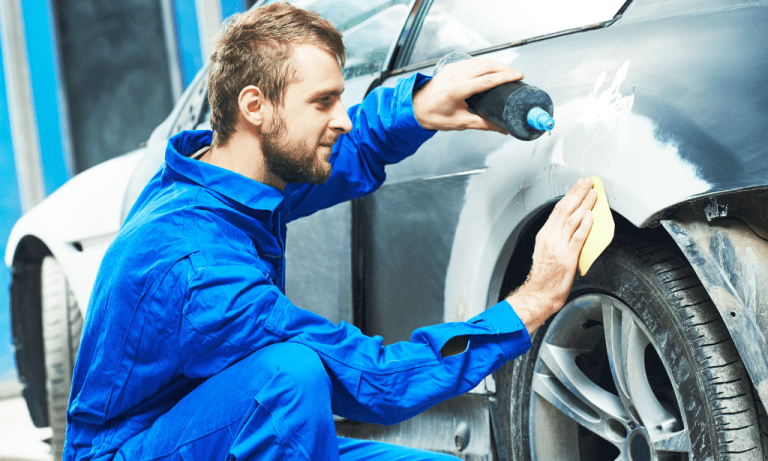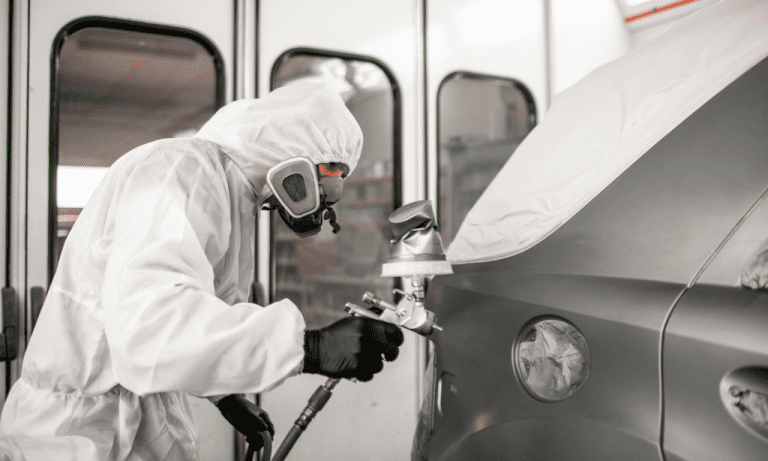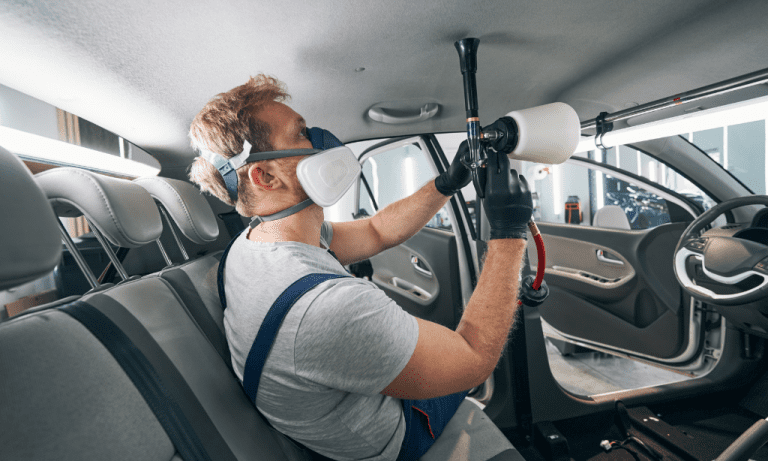Can You Sandblast Chrome Off A Bumper? Discover the Surprising Truth!
Yes, it is possible to remove chrome from a bumper using sandblasting. Sandblasting is an effective method for stripping away chrome plating from bumpers.
However, it should be done carefully to avoid damaging the underlying metal surface.
Understanding Chrome Plating On Bumpers
Chrome plating on bumpers not only enhances the aesthetic appeal of your vehicle but also provides added protection against corrosion and rust. Understanding the process of chrome plating and the benefits it offers can help you make an informed decision when it comes to maintaining or modifying your bumper.
Moreover, there may be situations where you consider sandblasting chrome off bumpers for various reasons. Let’s delve deeper into these aspects to gain a better understanding.
Process Of Chrome Plating:
- Chrome plating involves a multi-step process that starts with surface preparation, ensuring that the bumper is free from any dirt, grease, or imperfections.
- The bumper is then thoroughly cleaned and polished, followed by the application of a layer of nickel to improve adhesion.
- After nickel plating, a layer of chromium is electroplated onto the bumper, providing the distinctive shiny and reflective finish associated with chrome.
- The entire process is meticulously carried out to ensure a smooth and even layer of chrome on the bumper.
Benefits Of Chrome Plating On Bumpers:
- Aesthetics: Chrome plating gives your bumper a sleek and sophisticated appearance, elevating the overall look of your vehicle.
- Durability: The chrome layer acts as a protective barrier, safeguarding the bumper against rust, corrosion, and other forms of damage caused by environmental factors.
- Easy maintenance: Compared to other materials, chrome-plated bumpers are relatively easy to clean and maintain, requiring only occasional washing to keep their shine intact.
- Increased resale value: Vehicles with chrome-plated bumpers tend to have higher resale value, as the chrome finish is perceived as a premium feature by potential buyers.
Why People Consider Sandblasting Chrome Off Bumpers:
- Paint preparation: If you want to repaint your bumper or apply a different finish, sandblasting can effectively remove the existing chrome layer, providing a clean surface for further modification.
- Restoration purposes: In some cases, vintage vehicles with heavily damaged or deteriorated chrome bumpers require sandblasting to restore them to their former glory.
- Repairing imperfections: Sandblasting can help eliminate surface imperfections, scratches, or dents on chrome bumpers, allowing for subsequent repairs or refinishing.
Whether you wish to maintain the chrome plating on your bumper or opt for sandblasting, understanding the process and weighing the pros and cons will enable you to make an informed decision. By doing so, you can ensure that your vehicle’s bumper remains visually appealing while offering the necessary protection and longevity.
The Sandblasting Process Explained
Sandblasting is a popular method for removing unwanted materials, like paint or rust, from various surfaces. But can you sandblast chrome off a bumper? Let’s delve into the sandblasting process and find out.
What Is Sandblasting And How Does It Work?
Sandblasting, also known as abrasive blasting, is a technique that involves using compressed air or a centrifugal wheel to propel fine abrasive materials at high speeds onto a surface. The abrasive particles act as a powerful cleaning agent, stripping away unwanted coatings or contaminants.
Here’s a breakdown of the process:
- A blasting chamber or cabinet is used to contain the sandblasting operation, ensuring safety and preventing the dispersion of abrasive materials.
- Compressed air or a centrifugal wheel provides the force necessary to propel the abrasive material towards the surface.
- The abrasive material, such as sand or bead blasting media, is selected based on the desired level of aggressiveness and the material being worked on.
- As the abrasive particles strike the surface, they create a mechanical impact, effectively removing the unwanted material.
- The dislodged material and abrasive particles are then either collected for recycling or disposed of appropriately.
Suitable Materials And Techniques For Sandblasting Chrome
When it comes to chrome surfaces, special care must be taken during the sandblasting process to avoid damaging the underlying chrome layer. Here are some suitable materials and techniques to consider:
- Fine abrasive materials: To prevent unnecessary damage to chrome, it’s essential to use fine abrasives, such as aluminum oxide or glass beads. These materials are less aggressive and help maintain the integrity of the chrome surface.
- Low air pressure: Lowering the air pressure will reduce the impact of the abrasive particles on the chrome surface. It’s important to strike a balance between sufficient cleaning power and minimal damage.
- Masking techniques: Sometimes, certain areas of the bumper may need protection during sandblasting. Using masking materials like tape or rubber will prevent accidental abrasion on these sections while allowing the rest of the bumper to be properly cleaned.
Preparing The Bumper For Sandblasting
Before sandblasting a chrome bumper, thorough preparation is crucial to ensure optimal results. Here’s what you need to do:
- Clean the bumper: Remove any dirt, grease, or loose debris from the bumper using a mild detergent and water solution. This step will help improve the adhesion of the new coating.
- Remove any detachable parts: Take off any removable parts, such as lights or trims, to ensure complete access to the bumper’s surface during sandblasting.
- Mask sensitive areas: Identify any areas that you want to protect from sandblasting, such as plastic components or delicate chrome accents. Cover them securely with masking materials, ensuring tight edges to prevent any accidental damage.
- Choose a suitable blasting cabinet: Select a suitable sandblasting enclosure or cabinet that provides adequate ventilation and controls to contain the sandblasting process effectively.
- Practice proper safety measures: As sandblasting involves the use of abrasive materials and compressed air, it’s important to wear appropriate protective gear, such as goggles, gloves, and a respirator, to safeguard against potential hazards.
Now that you have a better understanding of the sandblasting process and the precautions to take when working with chrome bumpers, you can make an informed decision about whether you can sandblast chrome off a bumper. Remember to consult a professional or conduct further research to ensure the best outcome for your specific project.
Factors To Consider Before Sandblasting Chrome Bumpers
Sandblasting chrome bumpers can be an effective way to remove old paint, rust, and imperfections, providing a fresh canvas for a new finish. However, before diving into sandblasting, there are several factors that need to be carefully assessed. Not taking these factors into consideration can lead to costly damage and potential risks.
In this section, we will discuss the important aspects to consider before sandblasting chrome bumpers, including an assessment of the bumper’s condition, potential risks and damage during the sandblasting process, as well as alternative methods to explore.
Assessment Of Bumper Condition:
- Inspect the chrome bumper thoroughly to evaluate its overall condition. Look for any cracks, dents, or pitting that may affect the durability of the bumper during sandblasting.
- Determine the thickness of the chrome plating and whether it has any signs of deterioration. This will help you gauge how aggressive you can be during the sandblasting process without compromising the integrity of the bumper.
Potential Risks And Damage During Sandblasting:
- Chrome is a delicate material, and sandblasting can potentially remove or damage its thin layer of chrome plating. Be aware of the risks involved and exercise caution to avoid over-blasting or using abrasive media that may cause irreparable harm to the bumper.
- The impact of sandblasting on the underlying metal of the bumper should also be considered. Excessive or prolonged sandblasting can result in metal thinning or warping, leading to structural weakness.
Considerations For Alternative Methods:
- If the chrome bumper is in relatively good condition, consider other less aggressive methods like chemical stripping or hand sanding to remove the existing paint or rust. These methods can help preserve the chrome plating better while achieving satisfactory results.
- Another option is to hire a professional refinisher who specializes in chrome bumper restoration. They possess the expertise and proper equipment to handle the delicate process, ensuring a high-quality outcome without risking damage to the bumper.
Before proceeding with sandblasting chrome bumpers, it’s crucial to carefully assess the bumper’s condition, understand the potential risks and damage that may occur during the process, and explore alternative methods that may better preserve the chrome plating. By taking these factors into consideration, you can make an informed decision and ensure the best possible outcome for your chrome bumper restoration project.
Step-By-Step Guide To Sandblasting A Chrome Bumper
Sandblasting is an effective method for removing chrome plating from a bumper, giving it a fresh start for repainting or refinishing. However, it’s important to approach the process with caution to ensure safety and achieve the desired results. In this step-by-step guide, we will walk you through the process of sandblasting a chrome bumper, from gathering the necessary equipment to implementing proper techniques.
Let’s get started!
Gathering Necessary Equipment And Materials:
Before you begin sandblasting your chrome bumper, it’s essential to gather all the necessary equipment and materials. Here’s a list of what you’ll need:
- Sandblasting machine: A portable sandblasting unit or a sandblasting cabinet with sufficient capacity and pressure capabilities.
- Abrasive material: Choose between aluminum oxide grit or crushed glass media, both of which are suitable for sandblasting chrome.
- Safety equipment: Wear protective gear, including a respirator, safety glasses, gloves, and a long-sleeved shirt to shield yourself from abrasive particles and airborne contaminants.
- Air compressor: Ensure you have a reliable air compressor that can deliver the required pressure for your sandblasting setup.
- Bumper support: Use a sturdy stand or clamps to securely hold the bumper in place during the sandblasting process.
Safety Precautions During Sandblasting:
Sandblasting involves working with powerful equipment and abrasive materials, so it’s crucial to prioritize safety while undertaking this task. Here are some key safety precautions to keep in mind:
- Work in a well-ventilated area or use proper ventilation equipment to minimize the risk of inhaling harmful dust and fumes.
- Always wear the recommended safety gear, including a respirator, safety glasses, and gloves, to protect yourself from abrasive particles and airborne debris.
- Keep bystanders at a safe distance to prevent any accidents or injuries caused by flying debris or accidental contact with the sandblasting equipment.
- Read and follow the manufacturer’s instructions for your specific sandblasting equipment, including proper setup, operation, and maintenance guidelines.
Proper Techniques And Recommended Pressures:
To achieve the best results while sandblasting a chrome bumper, it’s essential to follow proper techniques and utilize the recommended pressures. Here’s what you need to know:
- Surface preparation: Clean the bumper thoroughly using a degreaser or a mild detergent solution to remove any dirt, grease, or contaminants.
- Test on a small area: Before sandblasting the entire bumper, it’s advisable to test the process on a small inconspicuous area to ensure it doesn’t damage the underlying surface.
- Adjust the pressure: Start with a low pressure setting to avoid damaging the chrome or the underlying metal. Gradually increase the pressure until you achieve the desired effect while being careful not to go over the recommended maximum pressure for your specific sandblasting setup.
- Maintain consistent movement: When sandblasting, keep the nozzle moving steadily across the bumper surface to prevent over-blasting in one area and ensure even removal of the chrome.
- Remove residue: After sandblasting, thoroughly clean the bumper to remove any remaining abrasive particles to prevent future issues with adhesion or corrosion.
By following this comprehensive step-by-step guide, you can safely and effectively sandblast the chrome off your bumper, providing a clean surface for further refinishing. Happy sandblasting!
Techniques To Minimize Damage During Sandblasting
Sandblasting is a common technique used to remove old paint, rust, and other surface contaminants from various materials, including chrome bumpers. However, given the delicate nature of chrome plating, it’s important to use proper techniques to minimize any potential damage during the sandblasting process.
In this section, we will explore some key techniques that can help protect your bumper and achieve the desired results.
Protecting Surrounding Areas During The Process
- Before you begin sandblasting, it’s crucial to protect the surrounding areas of the bumper that you don’t want to be affected by the process. Here are a few steps you can take to safeguard these areas:
- Cover adjacent portions of the bumper with a heat-resistant masking tape or painter’s tape. This will provide a buffer between the blasting media and the untouched sections of the bumper.
- Use plastic sheeting or drop cloths to shield any nearby surfaces, such as the vehicle body or nearby components, from overspray or abrasive particles.
Choosing The Right Abrasive Material
- Selecting the appropriate abrasive material is essential to ensure effective results without causing excessive damage to the chrome surface. Consider the following options:
- Aluminum oxide: This common blasting media is suitable for light to moderate surface cleaning and provides excellent cutting action without compromising the chrome plating.
- Glass beads: With their fine texture, glass beads are ideal for removing paint or rust from chrome bumpers while leaving the underlying finish relatively unscathed.
- Plastic media: If you’re dealing with delicate chrome plating, plastic media can be a gentle yet effective option to remove surface contaminants without causing damage.
Adjusting Pressure And Controlling Speed
- The pressure and speed at which you operate the sandblasting equipment significantly impact the outcome and potential damage. Follow these guidelines for better control:
- Start with a lower pressure setting and gradually increase it as needed. This approach allows you to assess the impact on the chrome surface and make adjustments accordingly.
- Ensure that the equipment’s nozzle is at an appropriate distance from the bumper, typically around 8 to 12 inches. Holding it too close may result in excess force and potential damage.
- Maintain a consistent sweeping motion during the sandblasting process to distribute the abrasive evenly and avoid focusing on one spot for too long.
By following these techniques, you can minimize the risk of damage while sandblasting a chrome bumper. Remember to exercise caution, use the right equipment, and, if unsure, consult a professional to ensure the best possible outcome for your bumper restoration project.
Happy sandblasting!
Pros And Cons Of Sandblasting Chrome Bumpers
Chrome bumpers are a popular choice for many vehicle owners due to their shiny and sleek appearance. However, over time, these bumpers can become worn, scratched, or damaged, diminishing their aesthetic appeal. In such cases, sandblasting is often considered as an effective method for removing the chrome layer and restoring the bumper to its original condition.
However, before opting for sandblasting, it’s important to weigh the pros and cons associated with this technique.
Benefits Of Sandblasting Chrome Bumpers:
- Efficient removal: Sandblasting is a highly effective method for removing chrome layers from bumpers. The high-pressure sand or grit propelled by the sandblasting equipment ensures thorough and efficient removal, offering excellent results.
- Restoration of original substrate: Unlike other methods that may damage the underlying substrate, sandblasting typically only removes the chrome layer, leaving the original bumper material intact. This allows for a complete restoration and ensures the bumper’s strength and durability remain uncompromised.
- Versatility: Sandblasting can be performed on various bumper materials, making it a versatile technique. Whether the bumper is made of steel, aluminum, or plastic, sandblasting can effectively remove the chrome layer, enhancing the potential for a successful restoration.
Potential Risks And Drawbacks To Be Aware Of:
- Damage to the bumper: While sandblasting is generally a safe method, it’s crucial to consider the potential risks. Improper execution or using excessive pressure can lead to damage to the underlying bumper material. It’s essential to entrust this task to a skilled professional to minimize the likelihood of any harm.
- Health and safety precautions: Sandblasting involves the use of abrasive materials, which can generate hazardous dust and debris. Protective gear, including a dust mask, safety goggles, and appropriate clothing, should be worn to ensure personal safety during the sandblasting process.
- Environmental concerns: Sandblasting can release abrasive materials and dust into the air, raising environmental concerns. It’s necessary to adhere to proper containment and disposal practices to minimize any negative impact on the surroundings.
Comparisons With Other Chrome Removal Methods:
- Chemical stripping: Compared to chemical stripping, sandblasting offers a more efficient and thorough removal of chrome layers. Chemical strippers may require multiple applications and extended soaking time, whereas sandblasting can achieve desired results in a relatively shorter duration.
- Manual sanding: Manual sanding can be a time-consuming and labor-intensive process compared to sandblasting. Sandblasting covers a larger surface area efficiently and avoids the risk of uneven patches that may occur with manual sanding.
Sandblasting is a viable option for removing chrome layers from bumpers, offering numerous benefits such as efficient removal, preservation of the original substrate, and versatility. However, it’s essential to consider the potential risks, such as bumper damage and taking appropriate health and safety precautions.
When comparing it with other chrome removal methods, sandblasting emerges as a more effective and time-saving choice. To ensure a successful restoration, it’s recommended to consult with professionals experienced in sandblasting chrome bumpers.
Common Mistakes To Avoid When Sandblasting Chrome Bumpers
Sandblasting chrome bumpers is often seen as a quick and effective way to remove the old paint and prepare the surface for a fresh coat. However, it’s crucial to approach this process with caution and avoid some common mistakes. By learning from these errors, you can ensure a successful sandblasting job that leaves your chrome bumper looking as good as new.
Overdoing The Sandblasting Process:
- Excessive pressure can damage the chrome finish and compromise the bumper’s integrity.
- Keep the sandblasting pressure at a moderate level to avoid causing irreversible damage.
- Opt for a gentle blasting media, such as fine glass beads or garnet. This will help minimize the impact on the chrome surface.
Neglecting Proper Equipment Maintenance:
- Regularly inspect your sandblasting equipment to ensure it’s in optimal condition.
- Clean the nozzle regularly to avoid clogs that can affect the blasting efficiency.
- Replace worn-out nozzles and hoses to maintain consistent performance.
Skipping Necessary Safety Precautions:
- Wear protective clothing, including goggles, gloves, and a respirator to shield yourself from airborne particles.
- Work in a well-ventilated area or use a dust collection system to minimize the inhalation of harmful dust.
- Keep a fire extinguisher nearby in case of any accidents or sparks.
By avoiding these common mistakes and taking the necessary precautions, you can successfully sandblast your chrome bumper without causing any damage. Remember, it’s always better to take your time and be meticulous in the process to achieve the desired results.
Alternatives To Sandblasting Chrome Bumpers
Can You Sandblast Chrome Off A Bumper?
When it comes to restoring the shine and finish of your chrome bumper, sandblasting may not be the only solution. While sandblasting is a popular method for removing unwanted paint and rust, it may not be suitable for chrome surfaces.
Fortunately, there are alternative techniques you can explore to effectively strip the chrome off your bumper. We will delve into some options that you can consider.
Chemical Stripping Methods
Chemical stripping is a commonly utilized method for removing chrome from bumpers. This process involves the use of strong chemicals that break down the chrome layer, making it easier to remove. Here are some key points to consider:
- Chemical stripping methods are effective in removing chrome but must be used with caution as they can damage the underlying bumper material if not done correctly.
- The process usually requires the use of corrosive chemicals, so it is essential to follow safety protocols and work in a well-ventilated area.
- Some popular chemical stripping products include chromic acid, muriatic acid, and phosphoric acid.
- Before applying any chemicals, it is vital to thoroughly clean and degrease the bumper surface to ensure the best results.
Professional Chrome Removal Services
If you’re not confident in your ability to strip the chrome off your bumper yourself, you can always turn to professional chrome removal services. Consider the following aspects:
- Professional chrome removal services have the expertise and equipment to effectively remove chrome from bumpers without causing any damage.
- These services generally employ various methods like chemical stripping, electrochemical stripping, or thermal stripping, depending on the specific bumper and its condition.
- While professional services may be more expensive than diy methods, they often provide superior results and save you time and effort.
Repainting Or Re-Chroming Options
Once the chrome has been stripped off your bumper, you may be left with a bare metal surface. Here are some alternatives for restoring its appearance:
- Repainting: After removing the chrome layer, you can choose to apply a fresh coat of paint to protect the bare metal surface and restore the bumper’s appearance. Make sure to use suitable automotive-grade paint and follow the necessary preparation and application steps for a long-lasting finish.
- Re-chroming: Another option is to have your bumper re-chromed by professional plating and metal finishing services. This process involves depositing a new chrome layer onto the prepared metal surface, providing a durable and shiny finish.
Sandblasting may not be the ideal method for removing chrome from bumpers. However, by exploring chemical stripping methods, professional chrome removal services, or repainting/re-chroming options, you can effectively restore your bumper’s appearance. Consider the condition of your bumper, your budget, and the desired outcome when choosing the most suitable approach.
Remember to prioritize safety and follow all instructions and guidelines during the chrome removal process.
Frequently Asked Questions On Can You Sandblast Chrome Off A Bumper
Can Sandblasting Remove Chrome From A Bumper?
Yes, sandblasting is an effective method to remove chrome from a bumper surface.
Is It Safe To Sandblast Chrome?
Sandblasting chrome is safe as long as proper safety precautions are followed, such as wearing protective gear and working in a well-ventilated area.
How Does Sandblasting Remove Chrome?
Sandblasting uses fine abrasive particles propelled at high speed to physically remove the chrome layer from the surface of the bumper.
Conclusion
Sandblasting can indeed be an effective method for removing chrome from a bumper. With the right equipment and technique, you can achieve a smooth and ready-to-paint surface that will give your vehicle a fresh look. It’s important to remember, however, that sandblasting can result in damage if not done properly.
Prior to beginning the sandblasting process, it’s crucial to adequately prepare the bumper by cleaning and protecting delicate parts. Seek professional assistance if you’re uncertain about handling the sandblasting on your own. Moreover, keep in mind that alternative methods like chemical stripping may be gentler on the bumper but may require more time and effort.
Consider your specific needs and expectations when deciding on the right approach for your bumper. Ultimately, with proper care and attention to detail, sandblasting can transform your bumper and breathe new life into your vehicle’s appearance.
- Protecting Your Truck Bed: A Guide To Truck Bed Covers - July 14, 2025
- Finding The Right 88-98 Chevy Truck Bed Cover - July 14, 2025
- Finding The Right 88-98 Chevy Truck Bed Cover - July 14, 2025



